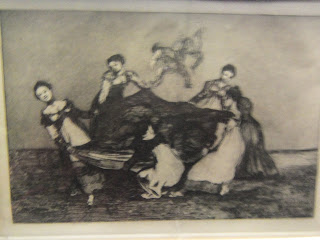For my last full day in Zaragoza, I wanted to go to the Museum of Zaragoza--which is supposed to have an archaeological exhibit as well as an exhibit on Goya.
However, what I found was a truly incredible exhibit on the Roman settlement in Zaragoza. This settlement was founded by Augustus sometime between 25 and 12 BC after his victory in the war in Cantabría and named Caesar Augusta. The city was constructed by war veterans.
The exhibit had some surprisingly large and complete mosaics.

Here's Pan fighting Eros with Psyche (with butterfly wings) in the background.

In this mosaic, Orpheus plays his lyre. Orpheus was known for his ability to charm with his music. Here, he charms a variety of different animals.

This mosaic depicts the victory of Bacchus over India.
The museum also had an exhibit on Goya. Francisco Goya was actually born in the region of Aragón. Later, he became the court painter for Carlos III and Carlos IV.
Goya wasn't afraid to paint the world as he saw it. For example, when he painted royalty, he didn't make them look more magnificent or larger than life. He painted them as they were. Goya received some criticism for this. In his painting of Carlos IV and his family, the Queen is in the center with the light focused on her--showing who really was the power behind the throne.
After an illness, Goya became deaf, and his paintings began to change. The resulting paintings are known as his "black paintings." Most famous among these paintings is "Saturn devouring his child." At this point in his life, he basically never left his house. In fact, he painted some of these "black paintings" on the walls of his home. After his death, they were removed from the walls and eventually taken to the Prado Museum in Madrid.
Here are a couple drawings from the exhibit.



No comments:
Post a Comment